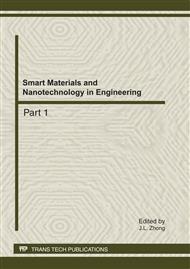[1]
S. Iijima, Helical mocrotubules of graphitic carbon., Nature, vol. 354, no. 6348, pp.56-58, (1991).
DOI: 10.1038/354056a0
Google Scholar
[2]
S. K. Smart, A. I. Cassady, G. Q. Lu, The biocompatibility of carbon nanotubes., Carbon, vol. 44, no. 6, pp.1034-1047, May (2006).
DOI: 10.1016/j.carbon.2005.10.011
Google Scholar
[3]
Y. Lin, S. Taylor, H. Li, et al, Advances towards bioapplications of carbon nanotubes., J. Mater. Chem., vol. 14 no. 4, pp.527-541, April (2004).
Google Scholar
[4]
Aryal Santosh, K. C. Remant Bahadur, N. Dharmaraj, et al, Synthesis and characterization of hydroxyapatita using carbon nanotubes as a nano-matrix., Scripta Materialia, vol. 54, no. 1, pp.131-135, January (2006).
DOI: 10.1016/j.scriptamat.2005.09.050
Google Scholar
[5]
B. Zhao, H. Hu, S. K. Mandal, et al, A bone mimic based on the self –assembly of hydroxyapaitite on chemically functionalized single-walled carbon nanotubes., Chem. Mater, vol. 17, no. 1, pp.3235-3241, (2005).
DOI: 10.1021/cm0500399
Google Scholar
[6]
L. Zhao, L. Gao, Novel in situ synthesis of MWNTS-hydroxyapatite composites., Carbon, vol. 42, no. 2, pp.423-426, January (2004).
DOI: 10.1016/j.carbon.2003.10.024
Google Scholar
[7]
A. Bianco, K. Kostarelos, M Prato, Applications of carbon nanotubes in drug delivery., Current Opinion in Chemical Biology, vol. 9, no. 6, p.674–679, June (2005).
DOI: 10.1016/j.cbpa.2005.10.005
Google Scholar
[8]
V. N. Khabashesku, J. L. Margrave, E.V. Barrera, Functionalized carbon nanotubes and nanodiamonds for engineering and biomedical applications., Diamond & Related Materials, vol. 14, no. 3-7, pp.859-866, March-July (2005).
DOI: 10.1016/j.diamond.2004.11.006
Google Scholar
[9]
S. Fiorito, A. Serafino, F. Andreola, et al, Effects of fullerenes and single-wall carbon nanotubes on murine and human macrophages., Carbon, vol. 44, no. 6, pp.1100-1105, May (2006).
DOI: 10.1016/j.carbon.2005.11.009
Google Scholar
[10]
J. Cglopek, B. Czaikowska, B. Szaraniec, et al, In vitro studies of carbon nanotubes biocompatibility., Carbon, vol. 44, no. 6, pp.1106-1111, May (2006).
DOI: 10.1016/j.carbon.2005.11.022
Google Scholar
[11]
S. Koyama, M. Endo, Y. A. Kim, et al, Role of systemic T-cells and histopathological aspects after subcutaneous implantation of various carbon nanotubes in mice., Carbon, vol. 44, no. 6, pp.1079-1092, May (2006).
DOI: 10.1016/j.carbon.2005.08.006
Google Scholar
[12]
C. W. Lam, J. T. James, R. McCluskey, et al, Pulmonary toxicity of single-wall carbon nanotubes in mice 7 and 90 days after intratracheal instillatio. , Toxicological Sciences, vol. 77, no. 1, pp.126-134, January (2004).
DOI: 10.1093/toxsci/kfg243
Google Scholar
[13]
D. B. Warheit, B. R. Laurence, K. L. Reed, et al, Comparative pulmonary toxicity assesment of single wall carbon nanotubes in rats., Toxicological Sciences, vol. 77, no. 1, pp.117-125, January (2004).
DOI: 10.1093/toxsci/kfg228
Google Scholar
[14]
G. Jia, H. F. Wang, L. Yan, et al, Cytotoxicity of carbon nanomaterials: single-wall nanotubes, Multi-wall nanotubes , and fullerence., Environ. Sci. Technol., vol. 38, pp.1378-1383, (2005).
DOI: 10.1021/es048729l
Google Scholar
[15]
J. Muller, F. Huaux, N. Moreaub, et al, Respiratory toxicity of multi-wall carbon nanotubes., Toxicology and Applied Pharmacology, vol. 207, no. 2, pp.221-231, Septemper (2005).
DOI: 10.1016/j.taap.2005.01.008
Google Scholar
[16]
N. A. Monteiro-Rivierea, R. J. Nemanichb, A. O. Inmana, et al, Multi-walled carbon nanotube interactions with human epidermal keratinocytes., Toxicology Letters, vol. 155, no. 3, pp.377-384, March (2005).
DOI: 10.1016/j.toxlet.2004.11.004
Google Scholar
[17]
H. Wang, J. Wang, X. Deng, et al, Biodistribution of Carbon Single-Wall Nanotubes in Mice., J. Nanosci. Nanotech., vol. 4, pp.1019-1025, (2004).
Google Scholar


